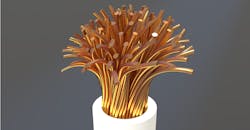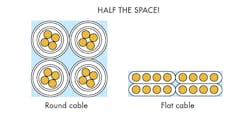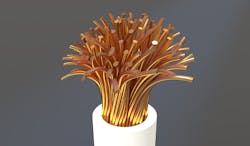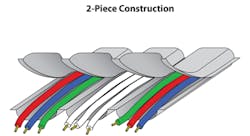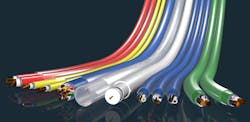Electrical engineers regularly turn to ubiquitous round-profile cables and wires. They are common and what they know. Flat cables began development in the late 1950s to address the more demanding requirements arising in aerospace applications. Engineers looking for an edge to improve product performance, reliability, packaging, and manufacturing can benefit by adopting a wider use of flat cable.
Advantages of Flat Cables
Flexibility is a key for any application involving motion, such as robotics, axis-control manufacturing equipment, automated medical diagnostic equipment. Because conductors are aligned parallel in a flat plane, the bend radius of flat cable is a fraction of common round cables. Under repeated bending cycles, conductors in round cable can kink or “corkscrew” causing failure and reducing cycle life. Flat cable can provide 15-million flex-cycle life. For applications with small bend radii and heavy flex cycling occurs, flat cable can provide a better solution.
Space: Electronics packaging continues to increase density. By nature of its shape, flat cable occupies roughly half the space of comparable round cable.
Weight: In addition to the reduction of unnecessary insulating, fillers and tapes, the composite flat-cable construction is so mechanically strong that it is not necessary to have large conductors for strength. The copper cross-section can thus be reduced to what’s required to carry the current load or to satisfy voltage-drop requirements.
Consistent Electrical Characteristics: Because the conductor spacing is fixed and the geometry of the cable is constant, the electrical characteristics, such as impedance, capacitance, inductance, time delay, crosstalk, and attenuation are consistent.
Greater Current Carrying Capacity: Flat cables have greater surface-to-volume ratio than their round cable counterparts, consequently having higher efficiency in dissipating heat. This allows a higher current level for a given temperature rise and conductor cross-section.
Reduced Skewing Effects: Due to the conductors having the exact physical and electrical length, along with a continuous and consistent dielectric, time delays between signals within a given flat cable are minimized.
Organization and Handling: Flat cable has the ability to reduce the number of separate conductors that must be managed. Disparate conductor types, such as twisted pairs, single conductors, coax, shielded and non-shielded types—for power and signal—can be combined into a single flat cable.
- A single flat cable containing a variety of conductors types can simplify design, assembly, and maintenance.
These benefits are inherent in flat cable and mostly unknown to the average design engineer. Flat cable is not always called for, but flat cable is more than just conductors in a different form factor. They provide a set of attributes that can solve many design challenges.
Flat Cable
The content above relates to flat cables compared to round cables. The following addresses what to look for in a flat cable.
Highest Flex Capability: While flat cable is inherently more flexible than round cable, there are differences in the flexibility among flat cables.
Fine Base Strands: If flexibility is important, look for a core of the finest base stranded wire.
At the core of Cicoil flat cables is the finest base stranded wire, typically two to three times as many finer strands than used in competitive “flexible” wire. Eliminating unnecessary insulating, fillers, and tapes reduces the bulk and physical volume of flat cables. In addition, their low profile enables them to hug surfaces and take advantage of tight or normally unused space. A rectangular cross-section allows flat cables to stack, or layer, with almost no wasted dead space between cables, providing maximum conductor density for a given volume.
Supple Jacketing: The jacketing material will also affect the flexibility of the cable. A Teflon jacketed cable may work well, but other options are available that can improve flexibility.
Conductor Integrity: Many types of flat cable loosely “pocket” conductors inside an outer jacket. Extruding the jacketing with the cable provides greater integrity by encapsulating the cable.
Flat cable features conductors that are able to be individually encapsulated via continuous extrusion in clear Flexx-Sil elastomere with no separate pieces or joins.
An advantage of the extruded full encapsulation is the elimination of conductor movement. Spacing and alignment is preserved for predictable electrical/signal performance. This improves service life by reducing or eliminating twisting, binding, chaffing or friction of conductors.
- Custom encapsulation: Another advantage if the extrusion process is the combining of all types of electrical conductors, fluid tubing, fiber-optics, mounting strips, and other elements into a single integrated cable.
Jacketing: The properties of the jacketing material will be important.
Temperature Extremes: Make sure the materials not only handle a range of temperatures, but also will stay flexible at low temperatures. Some jacketing material can handle temperatures from -65°C to +260°C, and stay flexible in temperatures as low as -100°C.
Flexibility: Silicone rubber can provide more than twice the flexibility as PVC or PTFE insulation.
Low Outgassing: This can indicate that the material has a strong molecular bond, and lower impurities.
Halogen-Free: Halogen may be necessary in some environments. In cases of fire, melting halogens, normally found in the jacketing material, can harm people escaping or fighting a fire.
Durable: The harder the material or higher the durometer can indicate the robustness of the jacketing material. This will vary on application, but making sure the jacketing material doesn’t wear may be important if a cable needs to be in motion.
Water/Chemical/UV Resistant: Jacketing material stability indicates water and chemicals don’t want to react with it. Furthermore, the materials may be exposed to UV or sunlight conditions. It is important to know how long a cable can operate in an environment whether water, chemical, or UV radiation, otherwise it may become brittle and prematurely fail.
- Shock and impact—Some applications may require the cable to with stand impact or shock loads. While the durometer might help give an indication on robustness, if a cable might see regular shock of 10Gs you will want to find a cable that will stand up to the abuse.
